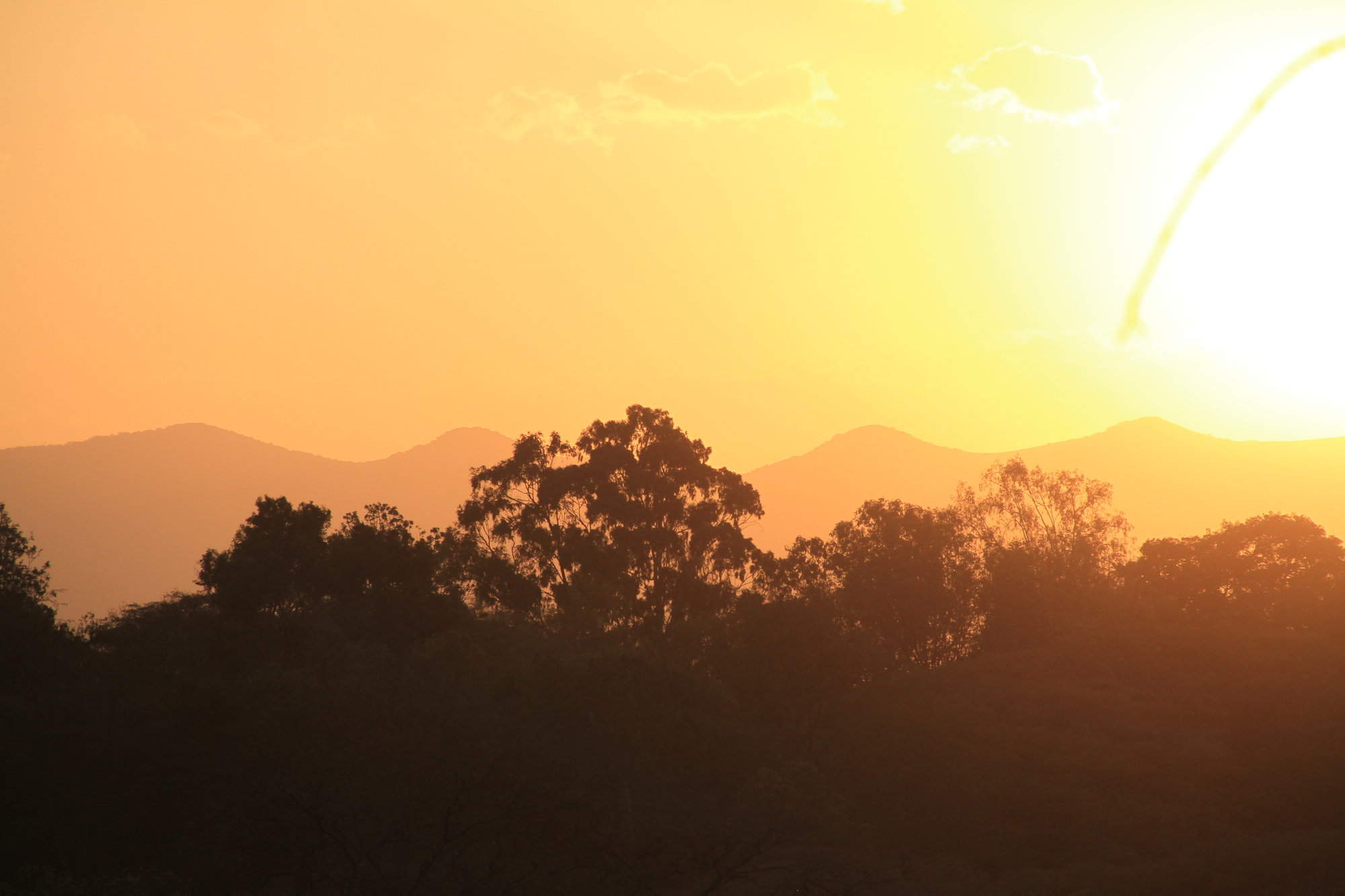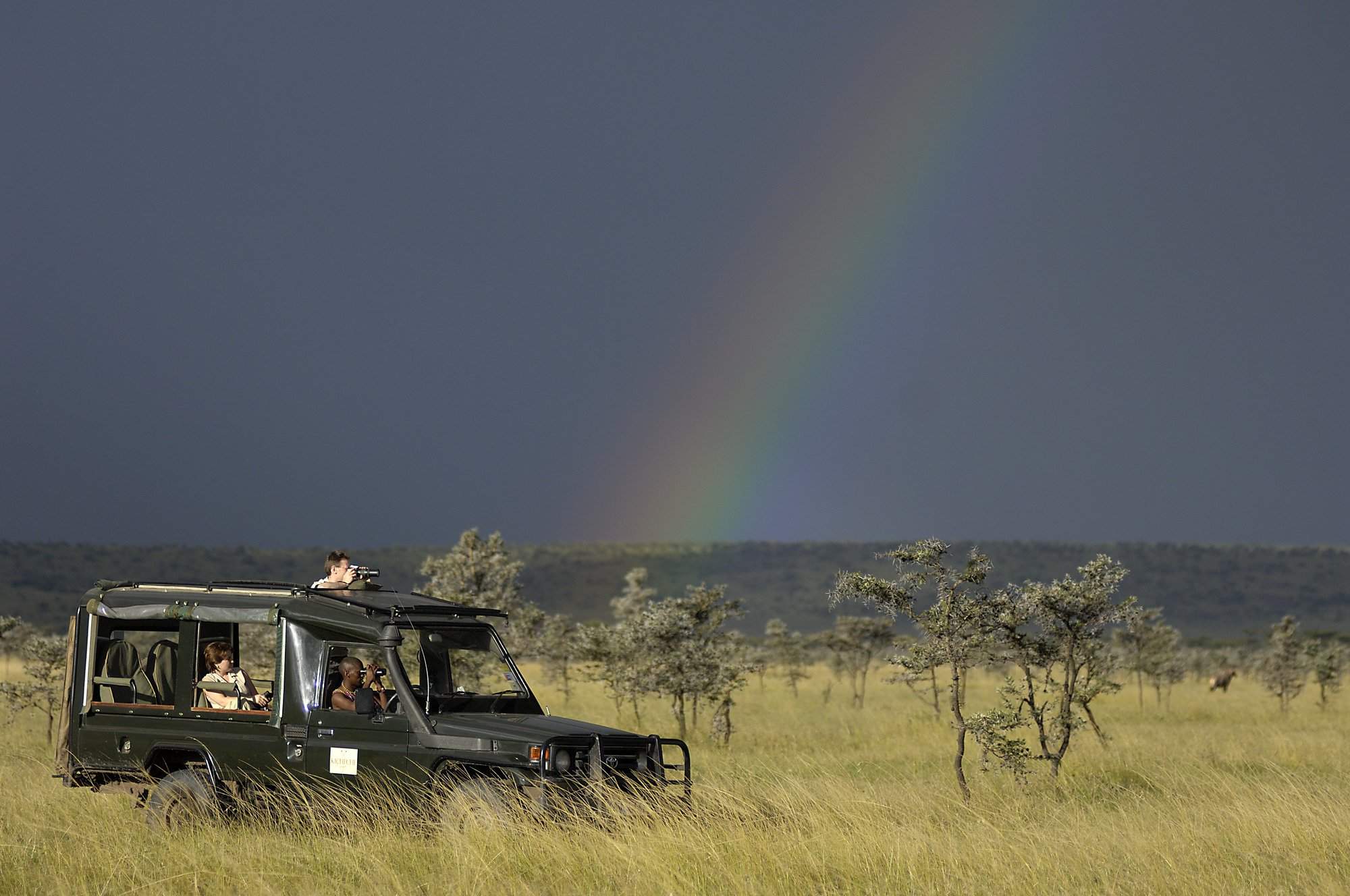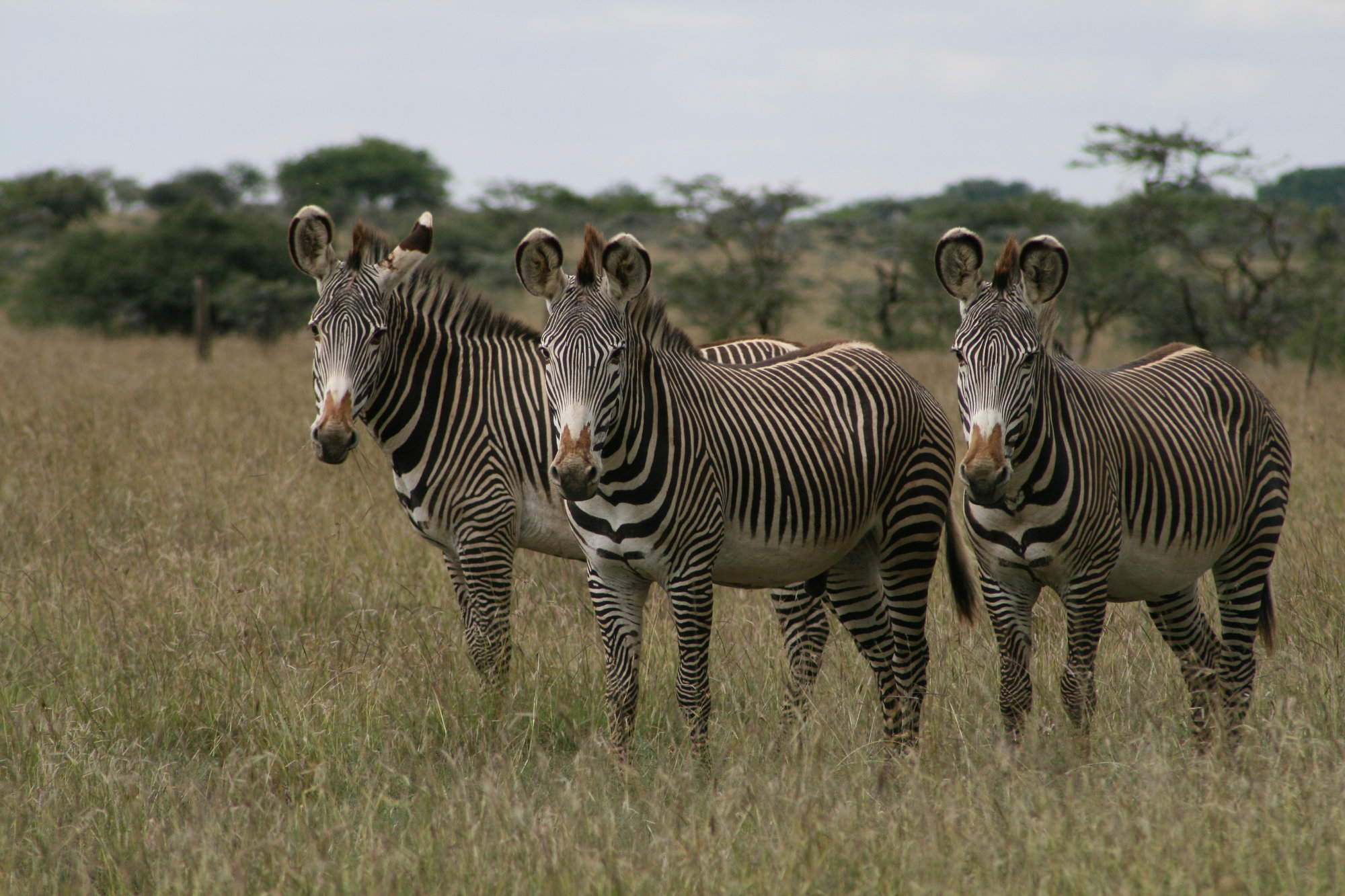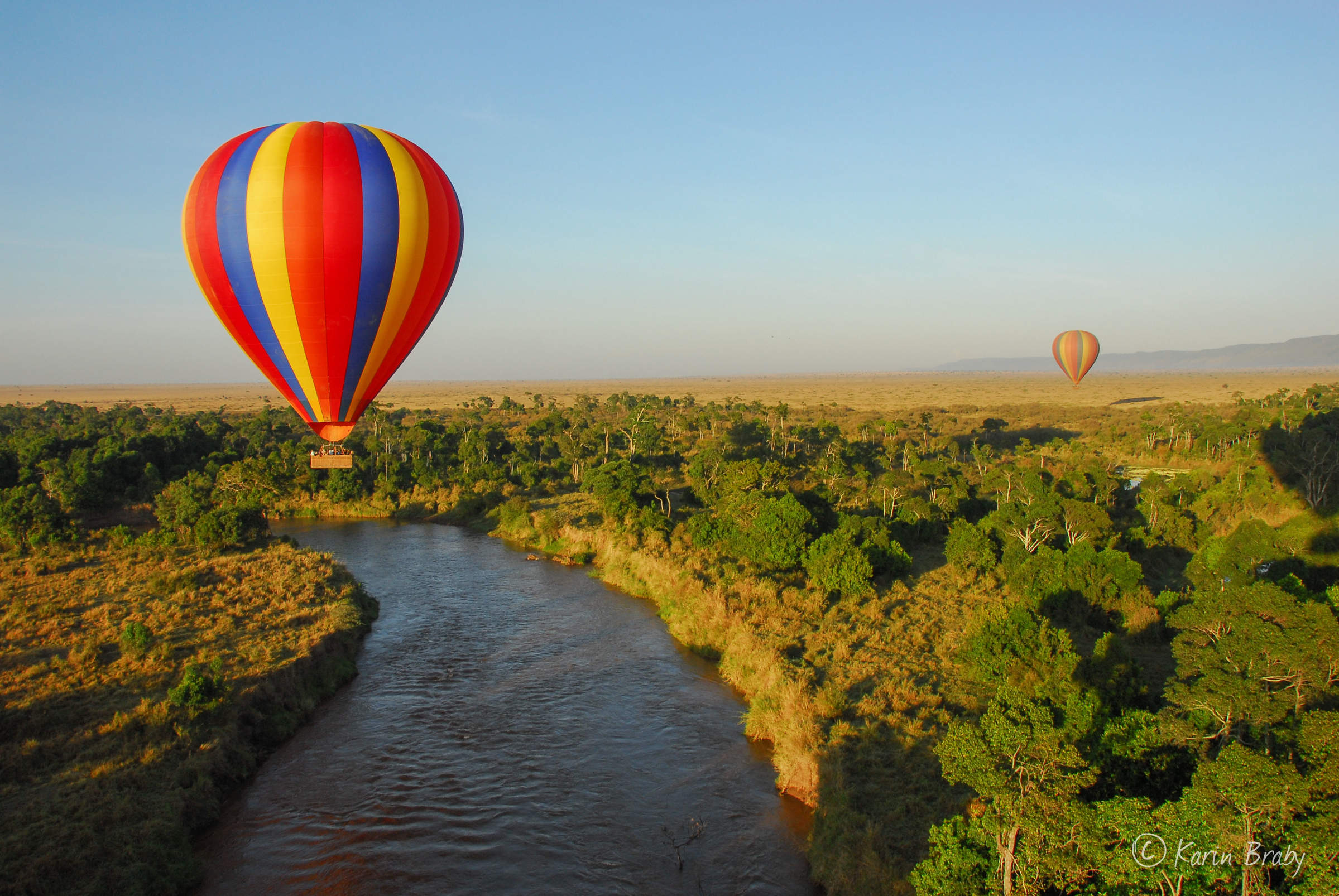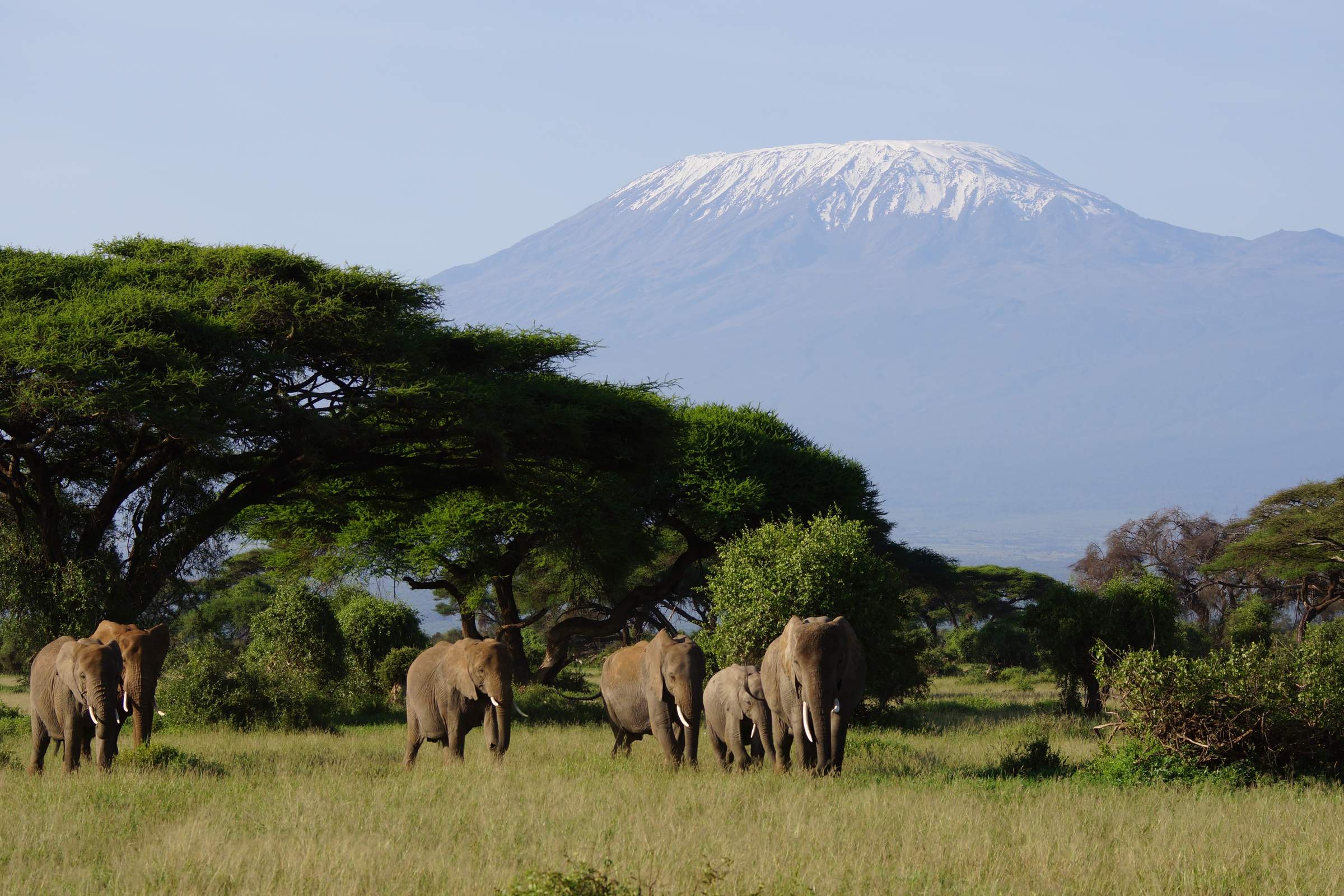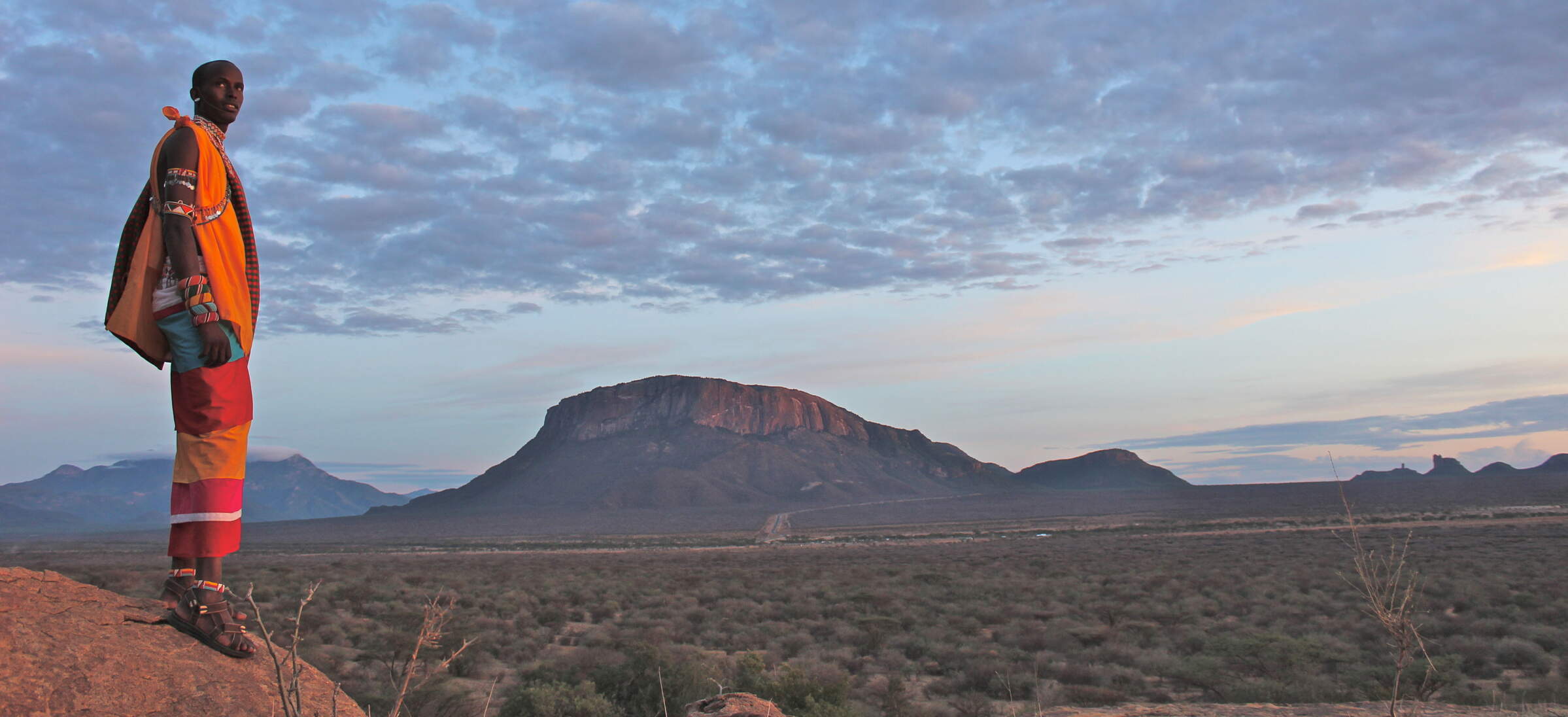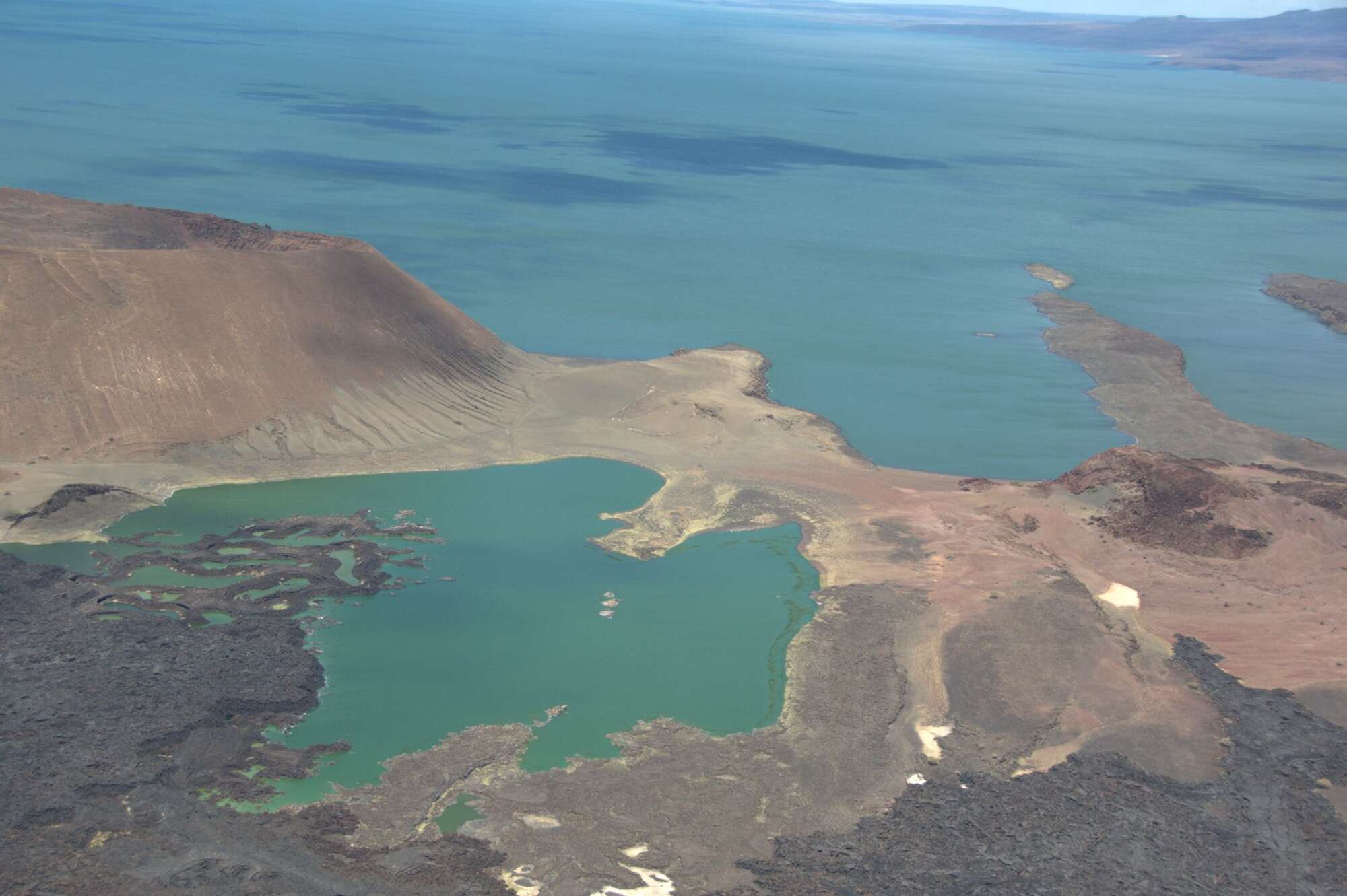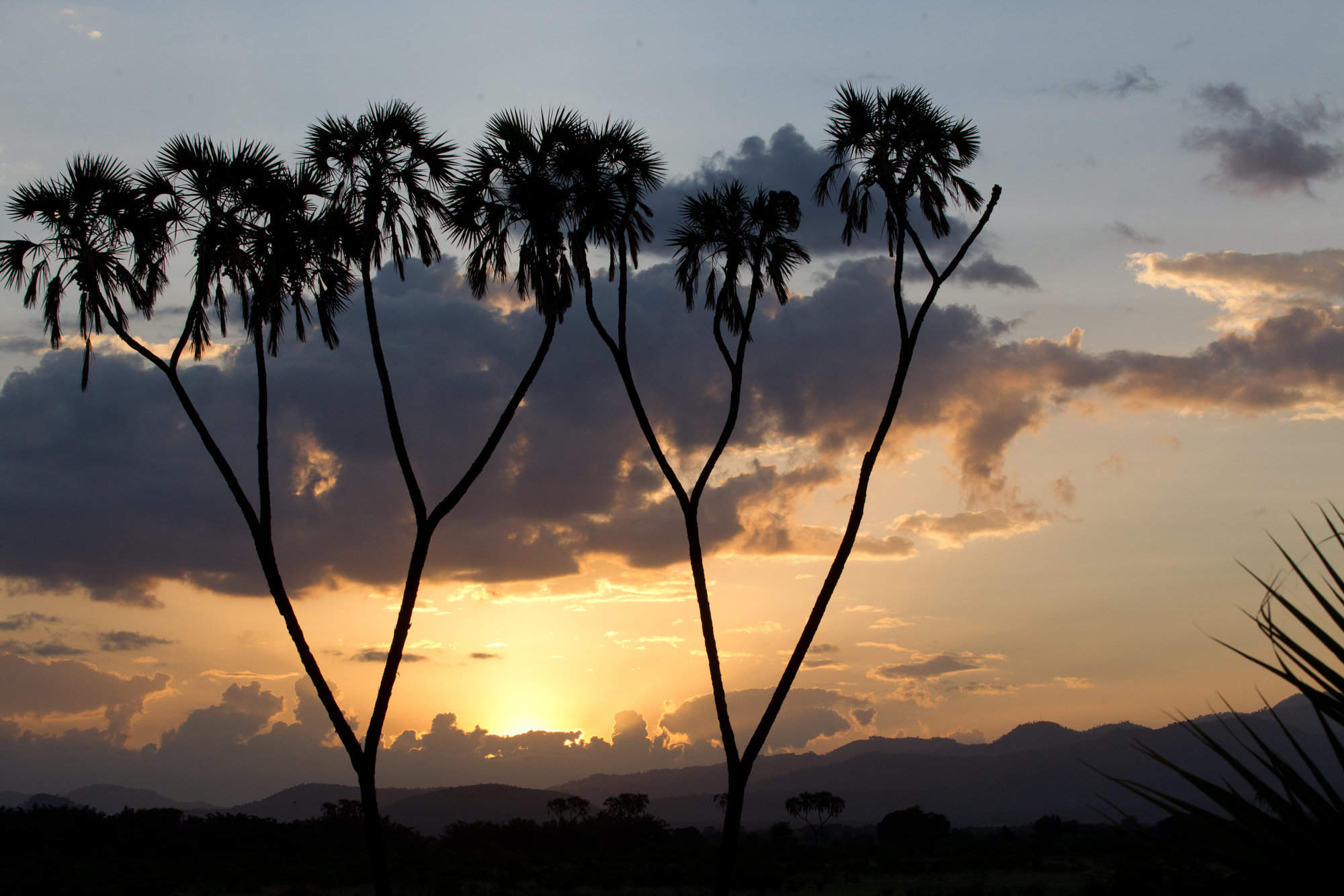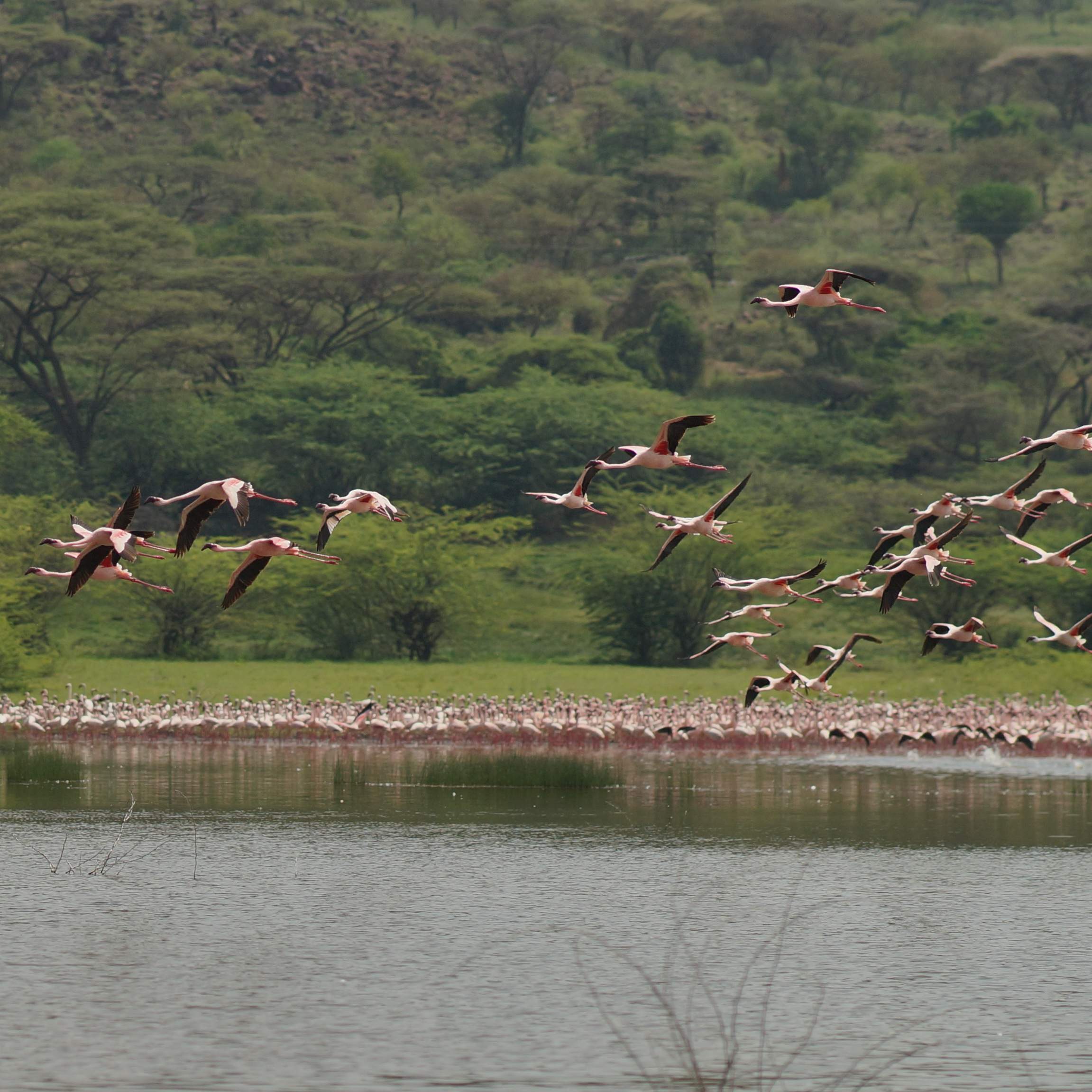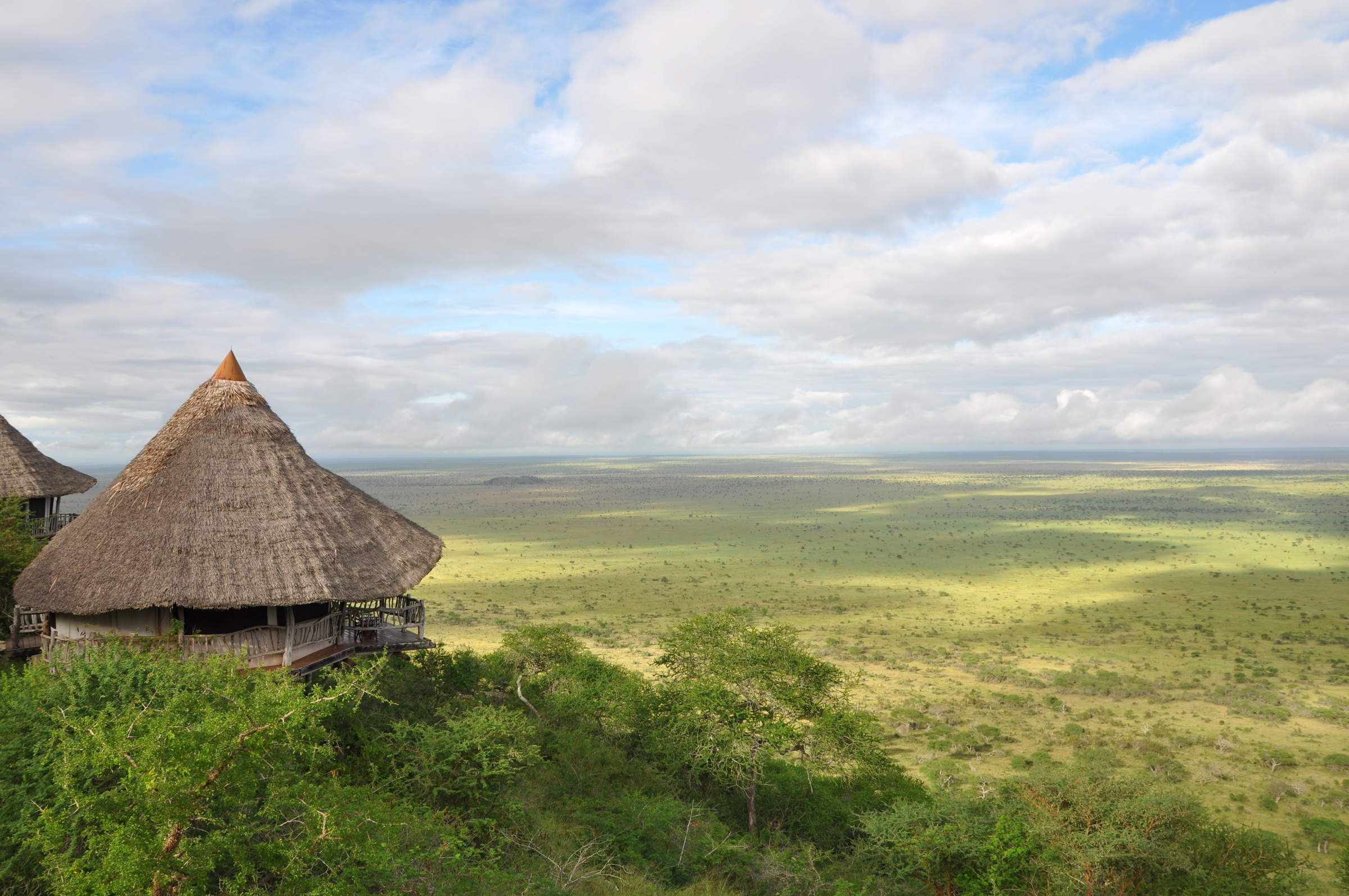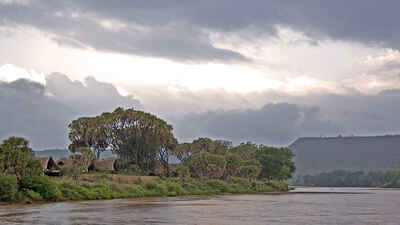
Tsavo East National Park is by far the biggest of Kenya's parks.
The Galana River attracts large numbers of wildlife...
...and big herds of elephants...
...can sometimes be spotted from just outside your tent.
There are relatively few camps and lodges...
...the majority of them close to Voi in the west, near the Mombasa highway.
Tsavo East National Park
Tsavo East National Park
This is the biggest of Kenya’s parks, famous for its herds of dust-red elephants.
Tsavo East National Park is by far the biggest of Kenya’s parks. At more than 13,700km², Tsavo East is nine times bigger than the Maasai Mara National Reserve: indeed you could fit the whole of the Mara reserve into the southern tip of Tsavo East National Park, south of the Voi River.
Tsavo East has another big draw: you can set off on a game drive across the seemingly empty wilderness and return to camp three hours later without having seen a single other vehicle. There are very few camps and lodges here and, relatively speaking, almost none, with the majority of them close to Voi in the west, near the Mombasa highway. You often have the park to yourself, watching the wildlife under a huge sky: no matter what you’re looking at, Tsavo East always feels like a big spectacle.
When considering a Tsavo East safari, it's worth knowing that nearly all safaris take place in the south of the park, south of the Galana River. The enormous northern region of Tsavo East was closed to the public for many years and, although it is now open again, distances are vast up here and there is virtually no infrastructure. In practice, it's an area for adventurous explorers, not game drives.
Incidentally, although Tsavo East and Tsavo West share a name – and a common border, coinciding with the Mombasa highway – they are two distinct national parks with different eco-systems: the wooded and hilly landscapes, dotted with volcanic cones and dramatic, black lava flows of Tsavo West National Park and the much flatter, more open plains and scattered bush that characterise Tsavo East National Park.
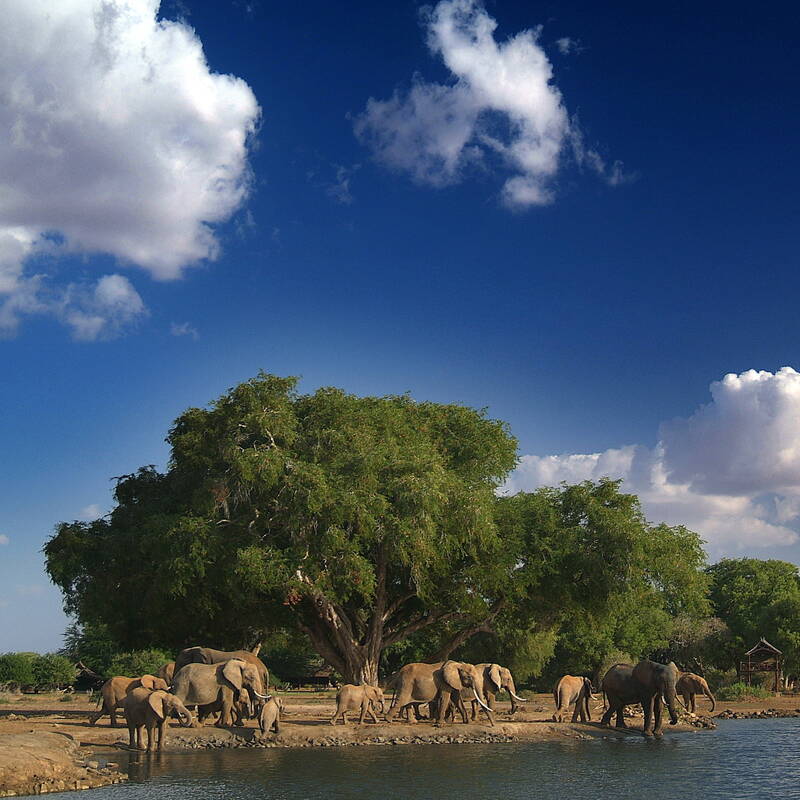
Safaris visiting Tsavo East
Just ideas, we'll always tailor-make a trip for you
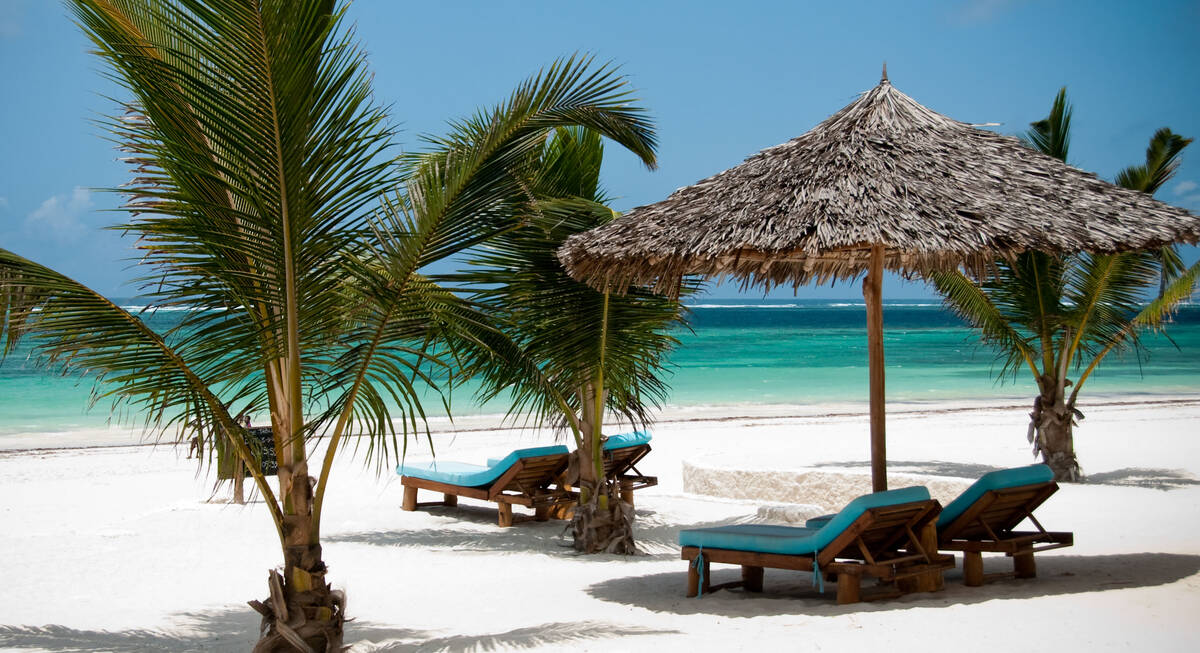
Elephant Safari
10 days • 3 locations
NAIROBI AIRPORT TO NAIROBI AIRPORT
This example of a mid-range Kenya safari and beach trip explores the wildlife of Tsavo West's volcanic plains and woodlands, Tsavo East's immense plains and the white-sand beaches and lush environment of Diani Beach.
US$5,850 - US$6,290 per person
Most recent reviews of our safaris to Tsavo East
Click below to browse all 15 reviews from Tsavo East National Park. All from our travellers; all are in full & unedited.
Arrived 9 Jan 2025, 18 nights
"My Jan 2025 trip"
Overall rating: Excellent
Arrived 27 Oct 2024, 7 nights
"Kenya 2024 "
Overall rating: Excellent
Arrived 12 Oct 2024, 15 nights
"My Oct 2024 trip"
Overall rating: Excellent
Arrived 1 Sep 2023, 9 nights
"My Sep 2023 trip"
Overall rating: Excellent
Arrived 17 Jan 2023, 13 nights
"My Jan 2023 trip"
Overall rating: Excellent
Arrived 8 Jan 2020, 19 nights
"A mixed bag indeed"
Overall rating: Average
Arrived 7 Mar 2019, 5 nights
"Satao / Tsavo "
Overall rating: Excellent
Arrived 29 Jan 2019, 13 nights
"Another Great Safari"
Overall rating: Excellent
Arrived 28 May 2017, 12 nights
"May-June Kenya, Tsavo trip was great"
Overall rating: Excellent
Arrived 28 Dec 2016, 11 nights
"Our Dec 16 to Jan 17 trip"
Overall rating: Excellent
Where to stay in Tsavo East
Our suggestions for safari camps in Tsavo East National Park
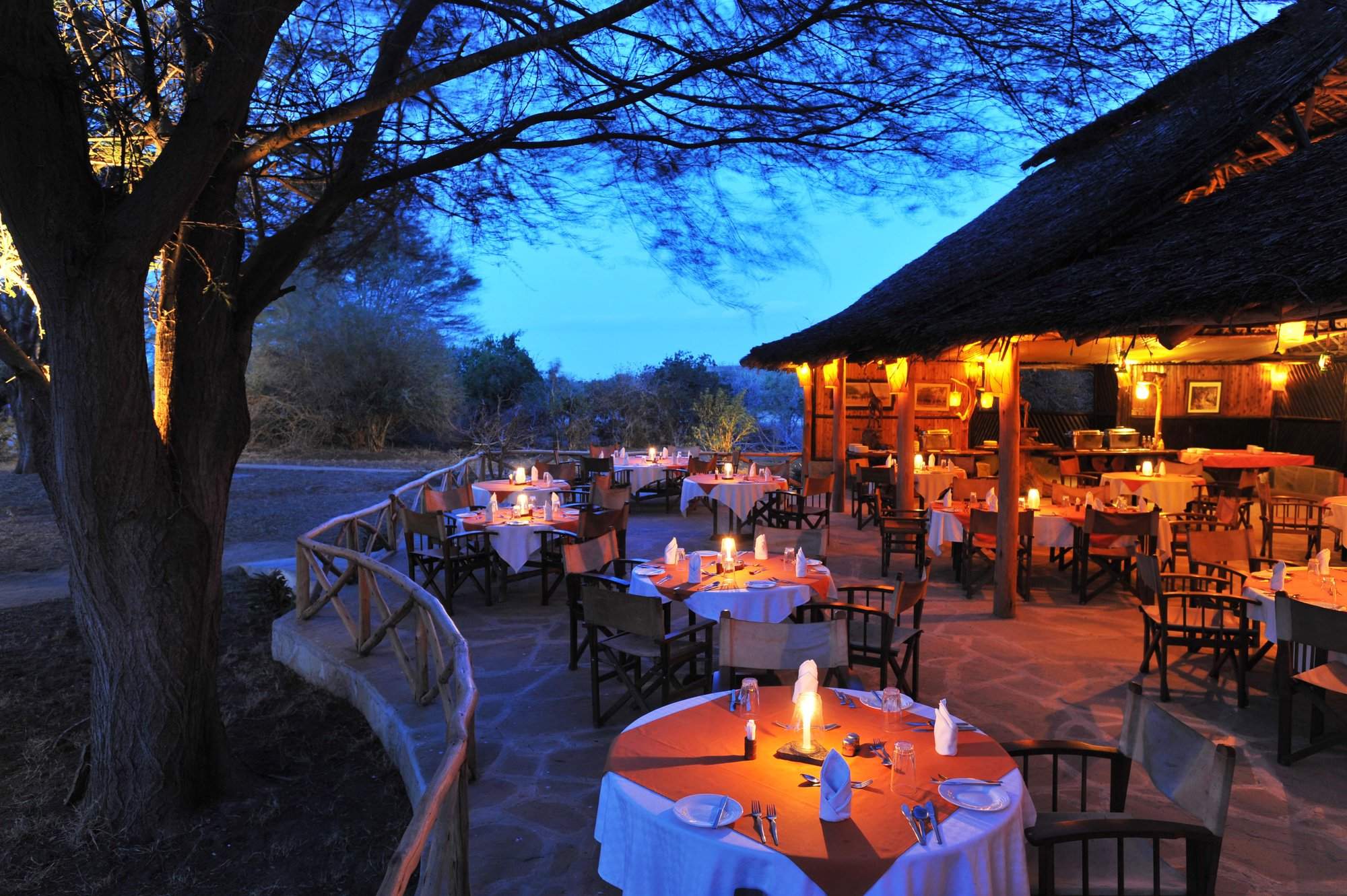
Satao Camp
Satao Camp is a traditionally styled, unfenced tented camp of generously sized tents set under shady trees around one side of a waterhole on a wildlife-rich plain in a remote part of Tsavo East National Park.
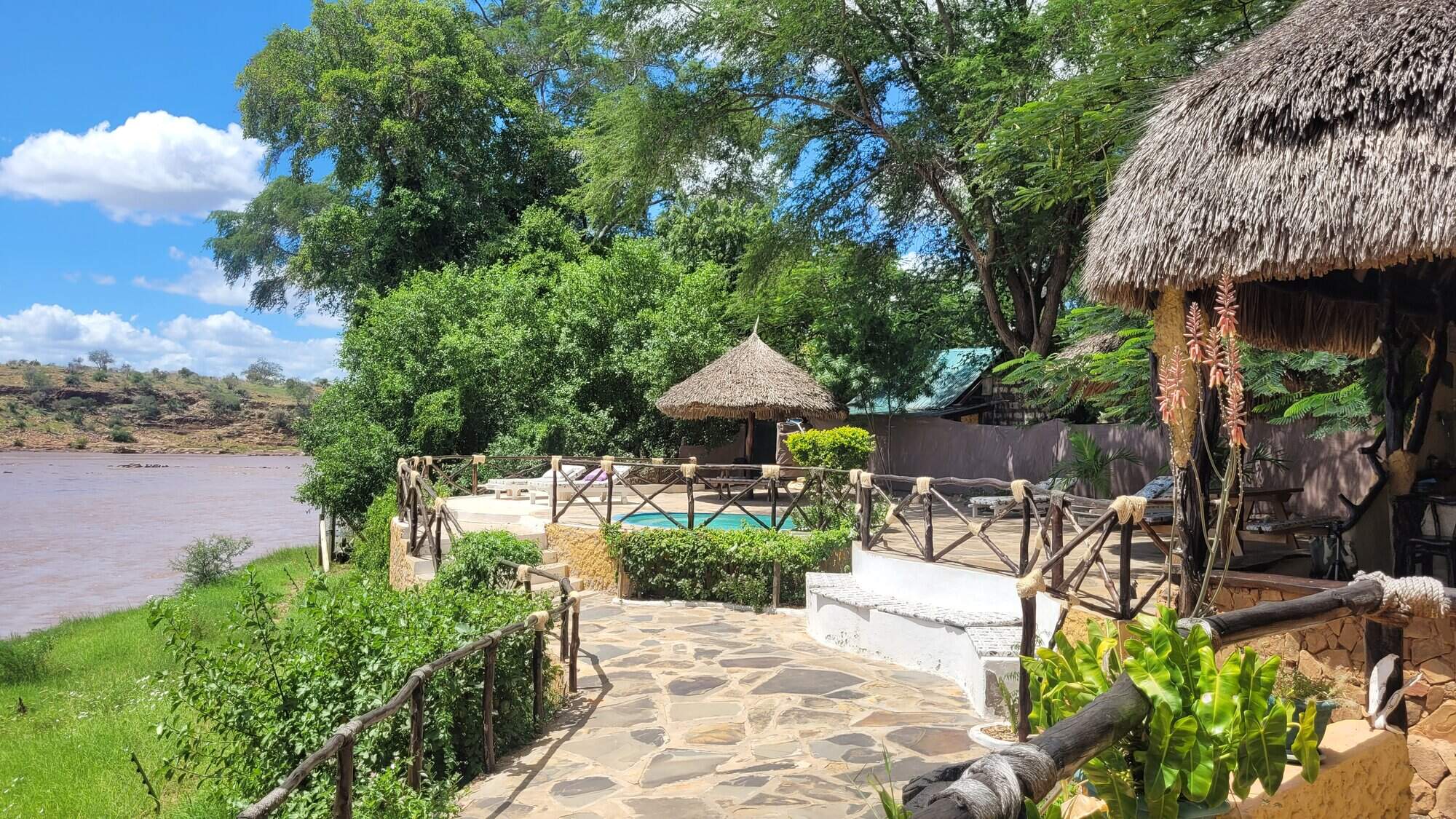
Kulalu Camp
Kulalu is a small camp on the banks of the Galana River, located on the outskirts of Tsavo East National Park and the Galana Conservancy.
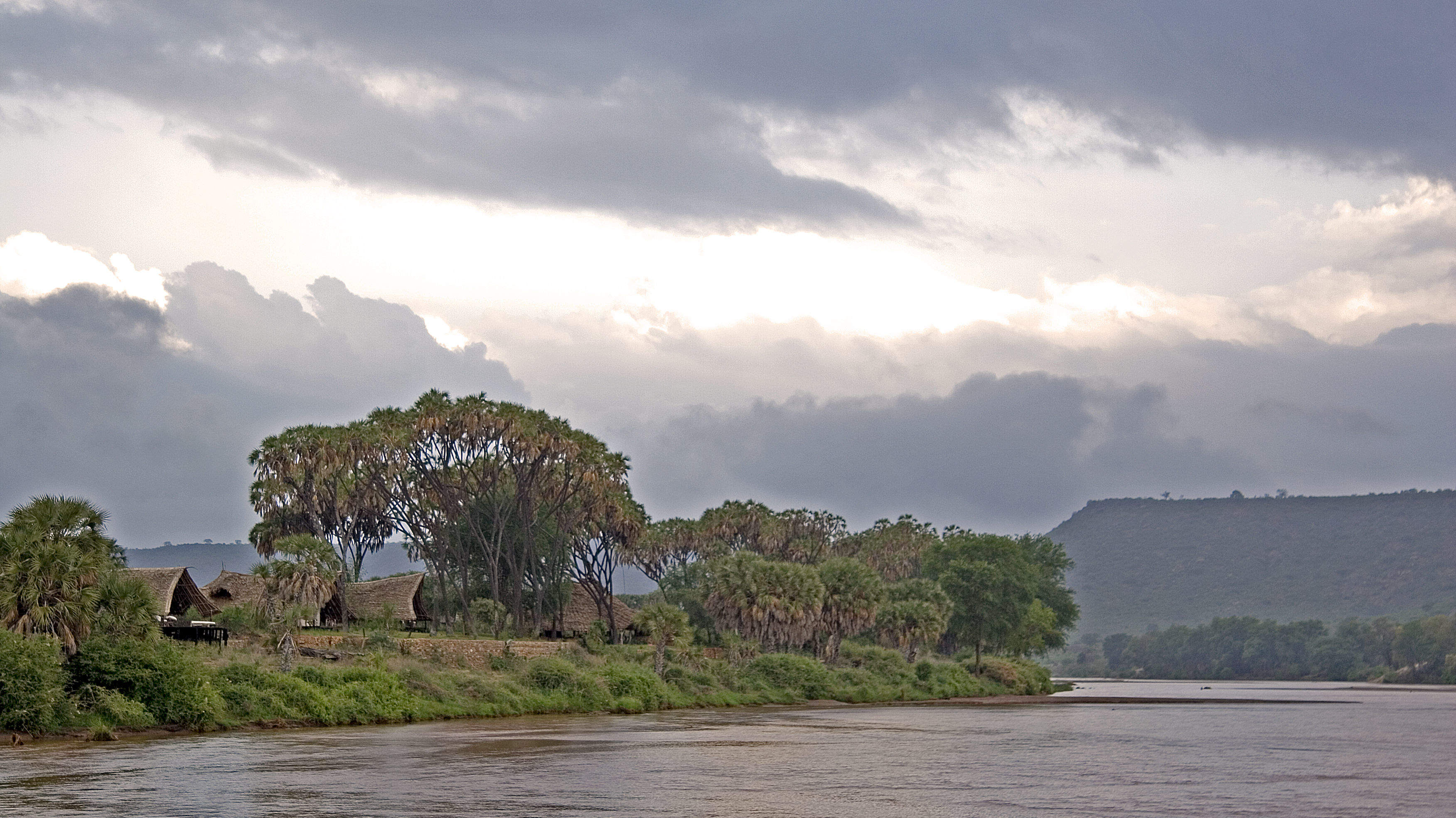
Galdessa
Galdessa is Tsavo East National Park’s best safari camp, sitting in a spectacular location on the banks of the broad Galana River.
Our travellers’ wildlife sightings in Tsavo East
This is their success for sightings in Tsavo East National Park. Click on a species for more detail. How we work this out.

100% success

100% success

100% success

90% success

80% success

80% success

80% success

70% success

60% success

50% success

33% success

20% success

10% success

0% success

0% success

0% success

0% success
When to go to Tsavo East National Park
Our month by month guide: What it's like to visit Tsavo East in Kenya
Jan
Feb
Mar
Apr
May
Jun
Jul
Aug
Sep
Oct
Nov
Dec
Kenya in January
Clear, hot days and warm nights make this high season a popular time for safaris and it’s also good for diving and snorkelling as water clarity is excellent and gets better as the dry season progresses. Most lodges and tented camps treat January after the New Year week is over, as mid-season, making it a good compromise in terms of value for money with reasonably reliable, dry weather and some greenery left in the landscape.
Expert Africa bases its description of climate and weather in January, like the other months of the year, on the climate records of roughly the last 100 years, and it's fair to say that the weather and seasons since the beginning of this century have been highly irregular and unpredictable.
- On average, January is the second driest month of the year
- Elephants dig waterholes in the dry riverbed in the Samburu reserve.
- Wildebeest and many antelope have their calving season, to February.
- Migrant birds are seen in huge numbers, especially in the Rift Valley.
- Sea water clarity around the coral reefs generally good.
Our view
Fantastic: the very best time to visit
Weather in January
Kenya in February
With the short dry season well established, the grass grazed down and wildlife gathering close to water points, this is still a good time for a safari. Good water clarity in the Indian Ocean's coastal waters makes for excellent diving and snorkelling conditions.
Expert Africa bases its description of climate and weather in February, like the other months of the year, on the climate records of roughly the last 100 years, and it's fair to say that the weather and seasons since the beginning of this century have been highly irregular and unpredictable.
- On average, February is the driest month of the year.
- It’s sometimes possible to swim with whale sharks at Diani Beach.
- Migrant birds are still seen everywhere, especially near water.
- This is usually peak calving season for wildebeest and many antelopes.
- This month is often the hottest of the year, especially on the coast.
Our view
A very good time to visit
Weather in February
Kenya in March
Hot, increasingly humid weather – with good diving and snorkelling conditions at the start of the month – gives way to rains and lower accommodation costs. Expert Africa bases its description of climate and weather in March, like the other months of the year, on the climate records of roughly the last 100 years, and predicting the seasons since the beginning of this century has been difficult.
March is the month when – traditionally – intensely hot conditions build up until a cloudburst finally happens at the end of the month or in early April, to relieve the humidity. As ever, regional variations across the country can greatly impact on visitors' experiences.
- Sea-water clarity is best for diving before the long rains start.
- Visitor numbers are low, though the Easter holidays can be busier.
- Night skies can be scintillatingly clear in early March.
- Cropped down savannah grasses can make it easier to see the wildlife.
- Temperartures climb high, especially at lower elevations.
Our view
A good time to visit, with pros & cons
Weather in March
Kenya in April
April sees the full onset of the southeast monsoon wind or kusi, which heralds the long rains. Temperatures drop soon after the rains are established and you’ll often have facilities largely to yourself in this more affordable low season, sometimes known as the "green season". The bush quickly springs to life, with greenery sprouting almost before your eyes. While you're likely to get a fair number of heavy showers, the breaks in the rain can yield sparklingly clear conditions.
With the dust settled and bright sun piercing the clouds, conditions can be sublime for photography, especially first thing in the morning or in the late afternoon with another storm brewing. You may be lucky, or you may find conditions very wet and muddy.
- A wet month, the coast often gets more than 300mm (12in) of rain.
- Sunny spells can provide great light for photography.
- Buffalo and zebra calving season often happens in this month.
- Baby crocodiles hatch, for example on Central Island in Lake Turkana.
- Palearctic migrant birds gather to fly north to breeding grounds.
Our view
A time to avoid if possible
Weather in April
Kenya in May
While game viewing can be trickier as vegetation runs riot, between the cloudbursts the colours and light are great for photography at this time of year. Expert Africa bases its description of climate and weather in May, like the other months of the year, on the climate records of roughly the last 100 years, and while it's reasonable to expect heavy rains in many parts during this month, especially on the coast, the rains don't always come evenly or in some areas come at all.
In an El Niño year, the so-called long rains that normally are established across much of the country by May can be meagre, to the despair of farmers. On the other hand in a La Niña year, the long rains can bring floods. On the coast, the monsoon winds make the climate much more predictable, with heavy rains common throughout this month.
- Frogs breed in the ponds in the Arabuko Sokoke Forest near Watamu.
- Wildebeest, impala and other grazers are in rut (the breeding season).
- Kilimanjaro looks its best as heavy rain falls as snow on the summit.
- There's a sharp peek of rainfall on the coast with many rainy days.
- Accommodation prices are uniformly low, while some camps close.
Our view
A time to avoid if possible
Weather in May
Kenya in June
The rains give way to cloudy, cooler weather, often making for comfortable conditions by the end of the month, especially in the highlands. Starting from mid-June or the beginning of July and running until the end of October, this is the high season, and accordingly has higher accommodation rates and – at least until early September – higher numbers of visitors.
While the early part of June can often be rainy on the coast, it can be a great time to go on safari, with fresh greenery, many young animals and good photographic conditions with clear air.
- The Taru Desert, inland from the coast, is carpeted with flowers.
- The Lake Turkana Cultural Festival is held in Loiyangalani.
- Madaraka Day (commemorating self rule) is 1 June.
- The annual Lewa marathon runs a course through the wildlife.
- The Diani Rules "sports" event rips up the rulebook at Diani Beach.
Our view
A good time to visit, with pros & cons
Weather in June
Kenya in July
Kenya’s “winter" season sets in (winter is a misnomer but locals feel the change), and the highlands can be rather grey. Skies are often cloudy and the days can be surprisingly cool, with an average daytime high in many highland safari areas of 15-20°C and night-time temperatures dropping below 10°C in Nairobi and the highlands. Lower parts of the country and the coast are usually warm and dry, typically reaching highs of around 25°C with lows in the high teens.
As this is the start of the high season, coinciding with the usual arrival of the wildebeest migration in the Maasai Mara, July is a busy month. Ask your Expert Africa specialist to advise on how to avoid the crowds, which is not that difficult to do.
- The wildebeest migration usually reaches the Maasai Mara in July.
- Simbi Lake (Kisumu) and Crater Lake (Naivasha) can attract flamingoes.
- Watersports start to pick up and some surfing is possible at Malindi.
- Afternoon thunderstorms are a common feature in the Maasai Mara.
- The sea can be choppy along the coast, making diving difficult.
Our view
A good time to visit, with pros & cons
Weather in July
Kenya in August
The Great Migration fills the plains of the Maasai Mara, and school’s out, so the park roads are full of tourists – ask your Expert Africa specialist for advice on crowd avoidance tactics. Choose a private conservancy rather than a public national park or national reserve for quieter conditions.
Like July, August is generally mild and relatively dry in the safari areas, but it can be very chilly in the highlands, even in the middle of the day, and hail occasionally falls above altitudes of around 2,400m (8,000ft). Nairobi can be disappointingly overcast, with low cloud.
- Apart from Christmas holidays, this is the busiest month of the year.
- Late August sees peak wildebeest drama at the Mara River crossings.
- Coastal winds are good for kite- and wind-surfing.
- Few mosquitoes are around at this generally dry time of year.
- The annual Camel Derby takes place in the Samburu capital, Maralal.
Our view
A good time to visit, with pros & cons
Weather in August
Kenya in September
The skies clearing of cloud signals the start of hot, dry weather with little chance of rain – and, after the first few days of the month, far fewer visitors – making the latter part of September a good time for a quieter safari. While early September is often good for dramatic migration crossings along the Mara River, you might consider deliberately postponing your trip until later in the month, when the migration can still be very impressive and visitor numbers fewer.
If tourist surges are somewhat predictable, however, the patterns of the wildebeest migration are more volatile, and like all of Expert Africa's climate and weather assessments, they are based on accumulated years of experience rather than guaranteed certainty.
- This is still high season, with prices to match.
- Many river crossings take place on the Mara river in both directions.
- Natural bush fires flush out insects and small animals for predators.
- The Rift Valley Music Festival takes place by Lake Naivasha.
- With school holidays over by early September, late-month is quieter.
Our view
Fantastic: the very best time to visit
Weather in September
Kenya in October
Still hot, mostly dry and not too busy, this is many people’s preferred month for a safari, and it’s also good for diving and snorkelling. The wildebeest and zebra herds of the great migration are often still to be seen, though in dwindling numbers. The swamps of Amboseli attract thirsty wildlife including large herds of elephants.
While we wouldn't expect much rain across most of the country this month, the climate has become so unpredictable that you can never say never, and the possibiity of the short rains – usually associated with November to mid-December, starting early, can't be discounted.
- This month sees the tail end of the great migration in the Mara.
- Palearctic migrant birds start to arrive, staying until March.
- Turtle nests hatch at Watamu, until November.
- Amboseli elephants focus on the swamps for their daily water.
- The Indian Ocean monsoon winds turn from southeast to northeast.
Our view
A very good time to visit
Weather in October
Kenya in November
The northeast monsoon wind or kaskazi heralds the start of the “short rains", usually some time in the second half of the month. From November to mid-December, this is the low season, and accordingly has lower accommodation rates and lower visitor numbers. Across most of the country you can expect warm, somewhat cloudy weather, with occasional heavy showers and localised flooding.
Expert Africa bases its description of the climate in November, like the other months of the year, on the records of roughly the last 100 years, and it's fair to say that the seasons since the beginning of this century have been highly irregular and unpredictable: some years the short rains don't come at all, or don't reach every part of the country. In an El Niño year, the November short rains can be very heavy, but in a La Niña year, they can fail completely.
- Swimming with dolphins in Lamu can be done from now until April.
- Birders gather at Ngulia in Tsavo West to ring Palearctic migrants.
- The Lamu Cultural Festival takes over the town and Lamu Creek.
- Agricultural shows often take place regional market towns.
- This is low season, so camps can be great value, with special offers.
Our view
A good time to visit, with pros & cons
Weather in November
Kenya in December
In a typical December, the rains usually finish by middle of the month, leaving the landscape looking its best, under clear blue skies, and heralding the start of the second peak tourist season from around 20 December to the first week of January. Our assessment of the likely weather in December, like the other months of the year, is based on climate records, and it's fair to say that the seasons since the beginning of this century have been highly irregular and unpredictable.
Christmas can sometimes be wet, but most years the rains have finished a week or two earlier, with the festive season ushering in the perfect combination of clear skies and sunshine by day and starry nights.
- Christmas and New Year are busy, with the lodges and camps full.
- Rates are highest after 24 Dec, with supplements on public holidays.
- Republic Day and Independence day are celebrated on 12 December.
- Good kite- and wind-surfing restarts, with strong northeasterly winds.
- Mango season begins, providing excitement for primates and elephants.
Our view
A good time to visit, with pros & cons
Weather in December
Tsavo East National Park: In detail
Tsavo East National Park
Tsavo East Safaris
The geography of Tsavo East
The Galana, which rises in the central highlands and whose upper reaches are known as the Athi, is one of Kenya’s biggest rivers. Its valley – rocky in much of its western course, sandy and doum-palm fringed further east – is one of Tsavo East National Park’s defining physical features.
Tsavo East landmarks
Mudanda Rock is an Ayer’s Rock-like sandstone inselberg whose bare flanks form a natural water catchment area that feeds into a large, seasonal lake, attracting large numbers of animals.
The Yatta Plateau is a 300km ancient lava flow that stretches along the east and north bank of the Athi-Galana. Its geomagnetic qualities are believed to play a role in guiding migratory birds and large numbers of Palearctic migrants can be seen in the area.
Lugard Falls are a series of short falls and steep rapids on the Galana River, where relatively harder rock has created a bottleneck in the valley and impedes the river’s progress. Crocodile Point, where the big reptiles can often be seen basking in the sun, is just downstream from here. At some point on most Tsavo East safaris, you're almost bound to stop here to stretch your legs and takes photos.
Wildlife of Tsavo East
If wildlife densities are much lower here than in some parks, the numbers and variety can be surprisingly good. On our own recent Tsavo East safaris we’ve usually seen the charactersitically short-maned Tsavo lions; cheetahs appear often; all the plains grazers and bush browsers are much in evidence; and those elephants never let us down: droves of them – many with big tusks – surge across the river, wallow in the waterholes and file over the red earth roads in front of bulging baobab trees. Poaching has been on the increase in recent years, but it hasn’t reached the epidemic levels of the late 1980s and the park is now much better equipped to deal with it.
Despite being in south-east Kenya, Tsavo East is zoologically associated with northern Kenya, meaning you’ll see long-necked gerenuk and Somali ostrich, the male of which has a blue neck and legs, and introduced herds of the handsome, fine-striped, Grevy’s zebra. There is also a breeding population of black rhinos, closely monitored by rangers who track them through the bush, though very few travellers on Tsavo East safaris are lucky enough to see them.
Galana Conservancy
The prehistory of the Tsavo region
The history of Tsavo East
While still restricted, like the hunter-gatherers, to areas of Tsavo East with water, which effectively meant the valley of the Galana River, the Kamba began to herd their livestock across the savannah and seek out bees' nests in the baobab trees. They subsequently went on to become great bee-keepers, famous across Kenya for their honey. They also refined the ancient art of poison-tipping their arrows, and for centuries, Kamba hunting arrows were at the forefront of hunting technology.
The exploration of Tsavo East
By the time the Maasai arrived in the Tsavo area with their cattle, in the eighteenth century, Swahili traders from the coast had been trekking across the region for centuries, using the Kamba as middlemen to exchange foreign cloth, alcohol, gold and silver coins and gunpowder for animal skins, ivory, rhino horn and slaves from the far interior. It was Swahili and Kamba traders who led the earliest explorers and missionaries on the world’s first 'safaris'. In 1849, they showed the German Bible scholar Johann Krapf the snowy peaks of Kilimanjaro and Kirinyaga (later called Mount Kenya), and in the 1880s they guided the eco-conscious Scottish geologist Joseph Thomson – the world’s first explorer to practice something resembling responsible travel (nobody ever lost their life on a Thomson safari) – on his way through Maasai-land.
The early Victorian colonists from Britain saw Tsavo East as a problem area to be fought against: they couldn’t farm there, but they were going to make sure their trains ran on time on the new railway line. Having dealt with two man-eating lions (the 'Man-Eaters of Tsavo') after losing dozens of labourers to the hungry pair during the railway’s construction, they were determined to avoid staff shortages over wildlife. Tsavo East’s dense population of black rhinos was considered to be a particular scourge, making footpaths and roads unsafe for pedestrians. As late as the years after World War II, the British employed the suitably named JA Hunter to cull the rhinos, and he quickly lived up to his name, killing 1088 rhinos over the course of a year in the area that is now Tsavo East National Park.
Tsavo East becomes a National Park
In 1948, there was a change of mind. The authorities declared that the area of Tsavo East would henceforth be protected as Tsavo East National Park. A decade after independence, the government of Jomo Kenyatta banned all hunting and tourists began to deliver an income to the region. Elephant and rhino poaching remained a serious problem however, spiking in the late 1970s as Middle East oil wealth began to purchase ivory and rhino horn dagger handles, and again in the late 1980s and early 1990s as Somalia’s economy disintegrated and refugees and weapons flooded the area. A third spike seems to be happening now, as China’s economy booms, though the park authorities, with private assistance, are better equipped to deal with poaching than in the past.
Map of Tsavo East National Park
Choices for where to stay in Tsavo East National Park
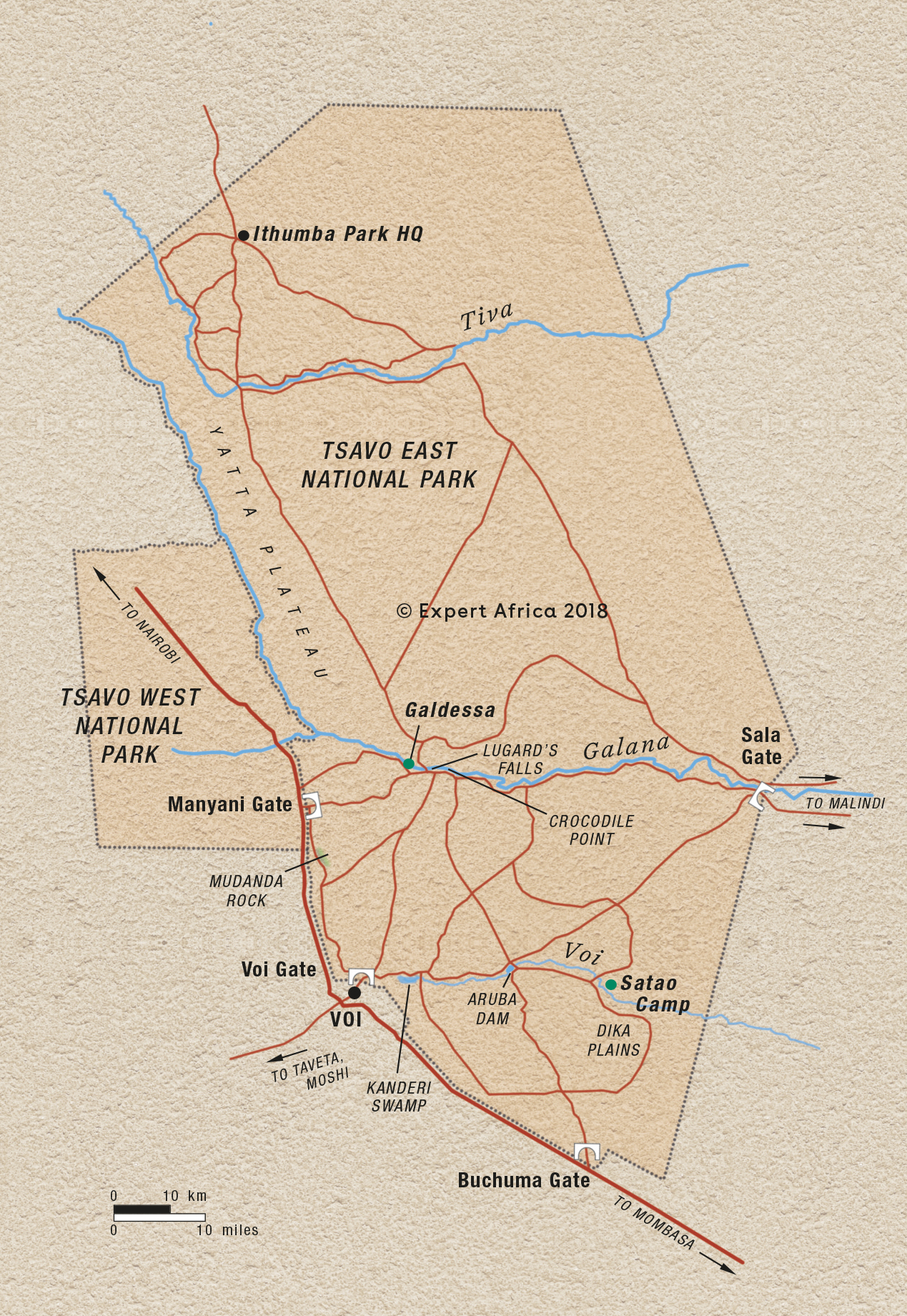
Tsavo East National Park: Safaris

Elephant Safari
10 days • 3 locations
NAIROBI AIRPORT TO NAIROBI AIRPORT
This example of a mid-range Kenya safari and beach trip explores the wildlife of Tsavo West's volcanic plains and woodlands, Tsavo East's immense plains and the white-sand beaches and lush environment of Diani Beach.
US$5,850 - US$6,290 per person
Top 3 lodges and safari camps in Tsavo East National Park
Tsavo East’s accommodation options are various but listed below are our favorite places to stay in this region. Ask us for more details of what's likely to suit you best!

Satao Camp
Satao Camp is a traditionally styled, unfenced tented camp of generously sized tents set under shady trees around one side of a waterhole on a wildlife-rich plain in a remote part of Tsavo East National Park.

Kulalu Camp
Kulalu is a small camp on the banks of the Galana River, located on the outskirts of Tsavo East National Park and the Galana Conservancy.

Galdessa
Galdessa is Tsavo East National Park’s best safari camp, sitting in a spectacular location on the banks of the broad Galana River.

Looking for inspiration on where to travel next?
Visit our trip chooser to explore your options and find inspiration for your perfect African adventure
Inspire me